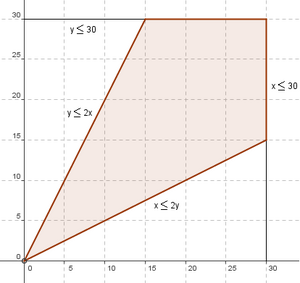Difference between revisions of "1998 AIME Problems/Problem 2"
m (→Solution 1: extra space?) |
(→Solution 2) |
||
| Line 17: | Line 17: | ||
=== Solution 2 === | === Solution 2 === | ||
| − | First, note that all pairs of the form <math> | + | First, note that all pairs of the form <math>(a,a)</math>, <math>1\le a\le30</math> work. |
| − | Now, considered the ordered pairs with <math>x < y</math>, so that <math>x < 2y</math> is automatically satisfied. Since <math>x < y\le 2x</math>, there are <math>2x - x = x | + | Now, considered the ordered pairs with <math>x < y</math>, so that <math>x < 2y</math> is automatically satisfied. Since <math>x < y\le 2x</math>, there are <math>2x - x = x</math> possible values of <math>y</math>. Hence, given <math>x</math>, there are <math>x</math> values of possible <math>y</math> for which <math>x < y</math> and the above conditions are satisfied. But <math>2y\le60</math>, so this only works for <math>x\le15</math>. Thus, there are |
| − | <math>\sum_{i=1}^{15} i=\frac{( | + | <math>\sum_{i=1}^{15} i=\frac{(15)(16)}{2}</math> |
| − | ordered pairs. For <math>x > 15</math>, <math>y</math> must follow <math>x < y\le 30 | + | ordered pairs. For <math>x > 15</math>, <math>y</math> must follow <math>x < y\le 30</math>. Hence, there are <math>30 - x</math> possibilities for <math>y</math>, and there are |
<math>\sum_{i=16}^{30}(30-i)=\sum_{i=0}^{14}i=\frac{(14)(15)}{2}</math> | <math>\sum_{i=16}^{30}(30-i)=\sum_{i=0}^{14}i=\frac{(14)(15)}{2}</math> | ||
| Line 29: | Line 29: | ||
ordered pairs. | ordered pairs. | ||
| − | By symmetry, there are also <math> | + | By symmetry, there are also <math>\frac {(15)(16)}{2} + \frac {(14)(15)}{2}</math> ordered pairs with <math>x > y</math> and the above criteria satisfied. |
Hence, the total is | Hence, the total is | ||
Revision as of 00:00, 6 March 2011
Problem
Find the number of ordered pairs ![]() of positive integers that satisfy
of positive integers that satisfy ![]() and
and ![]() .
.
Contents
[hide]Solution
Solution 1
Pick's theorem states that:
The conditions give us four inequalities: ![]() ,
, ![]() ,
, ![]() ,
, ![]() . These create a quadrilateral, whose area is
. These create a quadrilateral, whose area is ![]() of the 30 by 30 square it is in. A simple way to see this is to note that the two triangles outside of the quadrilateral form half of the area of the 30 by 30 square.
of the 30 by 30 square it is in. A simple way to see this is to note that the two triangles outside of the quadrilateral form half of the area of the 30 by 30 square.
So ![]() .
. ![]() we can calculate by just counting. Ignoring the vertices, the top and right sides have 14 lattice points, and the two diagonals each have 14 lattice points (for the top diagonal, every value of
we can calculate by just counting. Ignoring the vertices, the top and right sides have 14 lattice points, and the two diagonals each have 14 lattice points (for the top diagonal, every value of ![]() corresponds with an integer value of
corresponds with an integer value of ![]() as
as ![]() and vice versa for the bottom, so and there are 14 values for x not counting vertices). Adding the four vertices, there are 60 points on the borders.
and vice versa for the bottom, so and there are 14 values for x not counting vertices). Adding the four vertices, there are 60 points on the borders.
Since the inequalities also include the equals case, we include the boundaries, which gives us ![]() ordered pairs. However, the question asks us for positive integers, so
ordered pairs. However, the question asks us for positive integers, so ![]() doesn't count; hence, the answer is
doesn't count; hence, the answer is ![]() .
.
Solution 2
First, note that all pairs of the form ![]() ,
, ![]() work.
work.
Now, considered the ordered pairs with ![]() , so that
, so that ![]() is automatically satisfied. Since
is automatically satisfied. Since ![]() , there are
, there are ![]() possible values of
possible values of ![]() . Hence, given
. Hence, given ![]() , there are
, there are ![]() values of possible
values of possible ![]() for which
for which ![]() and the above conditions are satisfied. But
and the above conditions are satisfied. But ![]() , so this only works for
, so this only works for ![]() . Thus, there are
. Thus, there are

ordered pairs. For ![]() ,
, ![]() must follow
must follow ![]() . Hence, there are
. Hence, there are ![]() possibilities for
possibilities for ![]() , and there are
, and there are

ordered pairs.
By symmetry, there are also ![]() ordered pairs with
ordered pairs with ![]() and the above criteria satisfied.
and the above criteria satisfied.
Hence, the total is
![]()
See also
| 1998 AIME (Problems • Answer Key • Resources) | ||
| Preceded by Problem 1 |
Followed by Problem 3 | |
| 1 • 2 • 3 • 4 • 5 • 6 • 7 • 8 • 9 • 10 • 11 • 12 • 13 • 14 • 15 | ||
| All AIME Problems and Solutions | ||










